Upsetting the Apple Cart
It has long been the view of mainstream Egyptologists that the siting of each of the main pyramid structures at Giza was determined purely upon the wishes of the Pharaoh and the practicalities and logistics of a particular site. It is further held that the King’s decision for the siting of his pyramid gave little or no consideration to structures that had gone before or would come after. Each pyramid at Giza – so the conventional view asserts – was effectively constructed as a discreet Royal Funerary complex by each successive Pharaoh and was done so without reference to any pre-defined, master site plan. In short we are told that the pyramids at Giza were constructed as ‘singularities’ and that there existed no grand architectural scheme; no grand plan.
This conventional view of the pyramids at Giza runs contrary to the work of Robert Bauval who, in 1994 – in partnership with Adrian Gilbert – published his first book, The Orion Mystery, which presented the radical hypothesis that the pyramids at Giza were constructed as symbolic representations of the three belt stars of the constellation of Orion. By advocating such a hypothesis, Bauval was invoking the almost heretical notion that each of the pyramids at Giza was constructed as component parts of a pre-defined, long-term project; a multi-generational master plan that involved the belt stars of the constellation of Orion.
It is unsurprising that in making such a bold hypothesis, Bauval quickly incurred the wrath of the academic establisment. With a few notable exceptions, Egyptologists remained largely unconvinced by Bauval’s proposal, dismissing much of the cultural evidence he presented from the Ancient Egyptian writings known as the Pyramid Texts which provided considerable textual support to his work. The Egyptologists demanded that Bauval present conclusive evidence in support of his Orion hypothesis before they would even remotely consider over-turning a century and more of Egyptological consensus that staunchly regarded the Giza pyramids as three discreet Royal Funerary complexes constructed entirely independently of each other and on the whim of the particular Pharaoh in whose name the structure was apparently built.
Robert Bauval, however, remains steadfast in his view. Almost 15 years after first publishing The Orion Mystery, I met with Bauval in the shadow of the Great Pyramid and asked him his opinion concerning a very obvious anomaly at Giza. “If Khufu was the first Pharaoh of the Fourth Dynasty to build at Giza,” I put to him, “why then didn’t Khufu construct his Great Pyramid on the prestigious, high ground in the center of the plateau?”
Bauval turned to me and with his characteristic enigmatic smile, replied. “Because, Scott – there was a plan.”

Creighton (left) and Bauval at the Great Pyramid
In Keeper of Genesis/Message of the Sphinx (Bauval/Hancock, 1997), the authors show how this ‘grand plan’ may also have included the Great Sphinx at Giza which they hypothesize might have been designed as a reflection of the lion constellation of Leo in the eastern sky circa 10,500BCE. It seems that the designers of the Great Sphinx may have used the constellation of Leo as the underlying template for the design of this most recondite of all Giza structures. On this basis, might it not then be possible that the designers may have used the belt stars of Orion not simply to lay the pyramids on the ground in a near identical pattern to the belt stars, but to use the belt stars also as the underlying template from which to generate the actual dimensions – the base shape – of all three main Giza pyramids?
It hardly needs to be stated but if it can be demonstrated that the Orion belt stars can be used in a simple and consistent manner to generate three bases whose dimensions proportionally match those of the three main Giza pyramids then this would provide strong circumstantial evidence in support of Bauval’s Orion hypothesis.
But can this be done? Is it possible that the three belt stars of Orion can – when applying a very simple geometrical technique – be used to produce three bases that perfectly match the bases of the three great pyramids at Giza? Shortly we will investigate this idea but for the moment let us now consider some further ‘anomalies’ that exist at Giza for which there exists no convincing conventional answer.
Anomalies Abound
As already mentioned, if the final resting place of the Pharaoh was simply a matter of personal choice then we have to ask ourselves why Khufu should have chosen to locate his Great Pyramid (G1) at the very edge of the north-east corner of the Giza plateau. On the surface this would not seem a particularly odd choice. Looking closer, however, we find that the high, dominant ground lies in the center of the plateau where Khafre’s pyramid (G2), the second to be built at Giza, now stands. Not only is this central area the commanding ground on the plateau but it benefits also from having a ‘natural causeway’ that runs from the area of the Sphinx up to the east face of Khafre’s Pyramid. Even today, Egyptologists refer to this natural causeway as the ‘gateway to Giza’.
Why then, we ask, would Khufu choose to construct a quite monumental artificial causeway deep into the valley with all the costs and logistical problems such would incur when a natural causeway already existed up to the high, commanding ground of the plateau and which – had Khufu utilized it for himself – would have eased considerably the construction burden of his funerary complex?
Furthermore, by failing to claim for himself the highest ground on the plateau, Khufu would have been fully aware that he was leaving the door open for some future king to trump his own achievement by potentially building a higher pyramid in the highest ground of the plateau, which – as matters transpired – is precisely what happened – G2 (although slightly smaller) appears larger than G1 due to it having been built on the central high ground of the plateau.
The Ancient Egyptians were – first and foremost – very practical builders. And their kings clearly had egos to rival their monumental constructions. For Khufu to have decided against building his pyramid in the most practical and prestigious location on the plateau completely defies all rational thinking. Why would Khufu have risked having the magnificence of his own grand structure eclipsed by leaving the Giza door wide open for a future king to come along and surpass his own achievement? It makes no sense.
Turning now to Khafre, the builder of the second Giza pyramid (G2) – why did he decide to return to Giza when his older brother and predecessor, Djedfre, did not build at Giza like his father, Khufu, but instead opted to build his pyramid at Abu Rawash? Indeed, Khafre was the first King of the 4th Dynasty to ‘co-locate’ at the site of another Pharaoh (Khufu). Why did Khaf-RE (and indeed, Menkau-RE) decide to build at Giza when – from a religious perspective – it would have seemed more ‘appropriate’ for these two kings to have co-located with Djedf-RE (the first king of the emerging solar cult to have the name of the sun god ‘Re’ incorporated into the royal cartouche) at Abu Rawash?
And finally, we have Menkaure’s pyramid (G3) – the smallest of the three great pyramids at Giza. Once again it defies basic human instinct that Menkaure would have wished to locate his own infinitely smaller structure in the towering shadow of G1 and G2 where its relative diminutive stature would only have been exacerbated by its close proximity to its two illustrious neighbors. Had Menkaure sited his own structure at a virgin site he could have avoided the ignoble fate that assuredly awaited his pyramid by deciding to build at Giza. Why would Menkaure commit to Giza in the full knowledge that the pyramid he planned to build there would forever suffer the ignominy of having failed to match the very high standards set by his two predecessors? Again, it makes little sense.
Another very obvious anomaly pertains to the two sets of three smaller satellite pyramids known as the ‘Queens Pyramids’. Three of these structures run in a north/south line to the east of Khufu’s pyramid whilst the other set of three run in an east/west line just south of Menkaure’s pyramid (Figure 1).
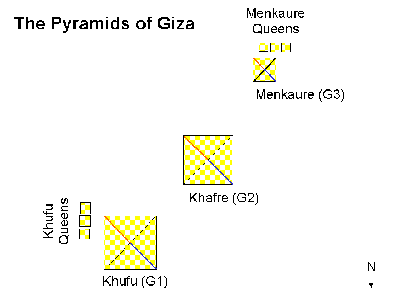
Figure 1 – The Great Pyramids of Giza with Queens Pyramids
As can be seen in Figure 1 above, Khafre’s Pyramid (G2) has no Queens’ Pyramids at all. This is somewhat odd since it is known that Khafre actually had five wives. Five queens and yet not a single Queen’s Pyramid is located at Khafre’s pyramid! There seems no consistency, no logic to this apparent anomaly. This situation seems all the more peculiar when one realizes that building Queens Pyramids for their wives was not normal practice at all for kings of the Old Kingdom and, indeed, of later dynasties.
What can also be observed from the diagram above is the NE/SW arrangement of the three Great pyramids. It is the orthodox view that this arrangement of the main pyramids would have offered the three Old Kingdom kings an unobstructed path to the stars of the northern and southern skies, the place they believed their soul would ascend to – Osiris (Orion) in the southern sky and to the circumpolar stars (known as the ‘Imperishable Ones’ because they never set) in the northern sky. However, it becomes immediately clear that if this was indeed their thinking then why would Menkaure ‘obstruct’ the southern face of his pyramid (i.e. the path to the stars of the southern sky) by building his three queens pyramids across its southern flank? And why build pyramids for the queens that do not also have an unobstructed path to the stars of the northern and southern skies? Why construct pyramids for their Queens where the path to the stars of the northern/southern skies are either blocked by each other or by another pyramid (G3)? Was it the case then that two of these Old Kingdom kings (Khufu and Menkaure), whilst happy to construct three pyramids for three of their queens, did not actually wish for the souls of their queens to ascend and join with them in the stars and, indeed, actually sought to prevent this by ensuring there was no clear path to the northern/southern stars?
The simple truth of the matter is this – if these Pharaohs felt it important enough to construct pyramids for their wives then surely it stands to reason that they would also have wished that the souls of their wives would join them as ‘Isis’ (consort of Osiris symbolized by the star, Sirius) in the heavenly Afterlife? Surely, if the arrangement of the pyramids is indeed an important aspect of pyramid building and religious thinking, then these two Giza kings would have ensured that their Queen’s pyramids were aligned in such a manner that these too would have had a clear, unobstructed path for their souls to ascend to the stars?
What we have here is clearly a contradiction. It simply does not stack up. This cannot be the reason why the three Great Pyramids are aligned along this NE/SW diagonal known as the ‘Lehner Line’. There must be another reason. And there must also be a reason that simply and rationally explains the building of queens’ pyramids in the first place and which also explains the lack thereof at Khafre’s pyramid.
Of course, all of these anomalies, contradictions and motives are simply and easily explained by the existence of a pre-defined, grand plan; a strict plan that the Ancient Egyptians of the 4th Dynasty – beginning with Khufu – felt compelled, indeed ‘duty-bound’, to implement on the ground at Giza.
From a purely logistical point of view, it would have made sense to build Khufu’s Pyramid (G1) first in the NE of the plateau since to have commenced the grand plan by building on the central high ground of the plateau, would have presented a considerable obstruction to later construction. Building had to begin in the northeast of the plateau in order to accommodate the logistics of building the structures that would come later in the plan. Given this constraint, Khufu – being the first to build at Giza – had little choice but to build his pyramid on the lower ground in the northeast of the plateau.
Think of it this way – had there been no pre-defined, master plan for later structures, there is little question that Khufu would undoubtedly have taken full advantage of the prestigious high ground in the center of the plateau for his own funerary complex. Khufu’s peculiar actions are very telling and demonstrate that his ‘hands were tied’; he was bound by the demands and logistics of a greater pre-defined plan; a plan he was seemingly powerless to influence.
In Search of the Master Key
Whether the pyramids at Giza were constructed as ‘singularities’ or as part of some greater scheme, it is not unreasonable to surmise that the builders would have followed plans of some kind. Alas, however, no blueprints of any Giza pyramid have ever been recovered.
However, even in the absence of any actual plans, it may still be possible to uncover the blueprint the ancient builders may have used to lay out and define the dimensions of the Giza monuments – and we can perhaps achieve this by reverse-engineering the geometry of the in-situ structures. The logic is simple – if the Giza pyramids were constructed as part of some pre-defined ‘master plan’ then it naturally follows that there would exist some guiding principle common to all three pyramids, an underlying design imperative – in short a ‘key’ to unlocking the Giza blueprint. Finding this ‘key’ would – in theory – demonstrate that the pyramids of Giza were not simply placed in an ad-hoc fashion on the whim of three successive Pharaohs. If such a design key can be found for the main pyramids an their queens this will provide powerful evidence that Giza was a unified, cohesive plan set out long before a single limestone or granite block was ever put in place. And it goes without saying but if this can be demonstrated then mainstream Egyptology has a much bigger problem and a lot of explaining to do.
The Key
Over the years the internet has spawned a veritable plethora of geometrical-mathematical offerings that attempt to seek the answer to the question of how the three main Giza pyramid base dimensions were arrived at and how the other satellite pyramids were placed in relation to these. So far, however, none of these offerings provides anywhere near a complete, cohesive solution to this vexing question; the master ‘key’ to unlocking the Giza blueprint remaining frustratingly elusive.
It has already been stated in the opening to this article that Robert Bauval has long argued that the 3 main Giza Pyramids were built and laid out on the ground at Giza as symbolic representations of the three belt stars of the Orion constellation and has provided considerable contextual evidence from the Pyramid Texts in support of his hypothesis. Assuming then that Bauval’s hypothesis is correct, could it be possible that the belt stars of Orion might reveal to us other aspects of the Giza pyramid design? Might it be possible that the belt stars of the Orion constellation could have been used as the ‘template’ from which to define the actual geometrical base dimensions of the three main Giza pyramids and allow us also to explain the somewhat puzzling and contradictory alignment and placement of the two sets of Queens pyramids? In short – could the Orion belt stars be the elusive design ‘key’; the underlying Giza design imperative sought by so many for so long? Can it be shown that Giza is the product of a pre-defined plan that the vast majority of Egyptologists dismiss?
Well, let us see.
The Orion ‘Geo-Stellar Fingerprint’
Any three non-linear points (in this case the 3 stars of Orion’s Belt) can be used to generate three square bases, simply and easily, using a technique that has come to be known as ‘geo-stellar fingerprinting’. The following diagrams show how the Orion belt stars can be used to produce their very own ‘geo-stellar fingerprint’.
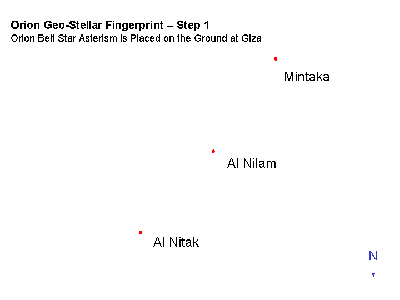
Figure 2
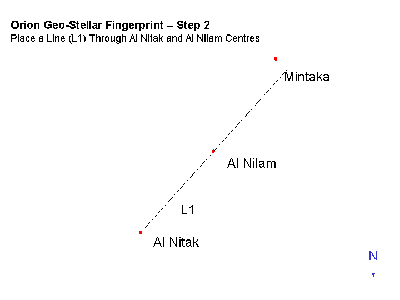
Figure 3
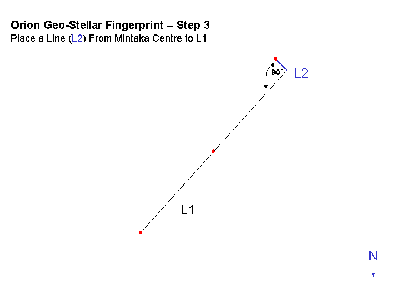
Figure 4
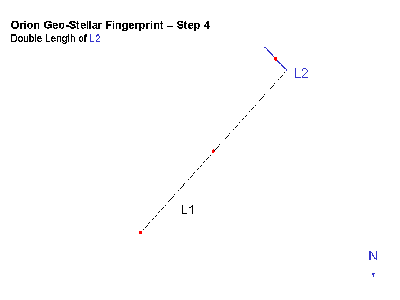
Figure 5
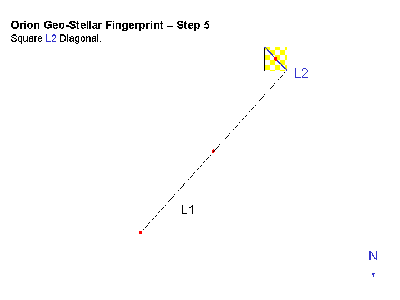
Figure 6
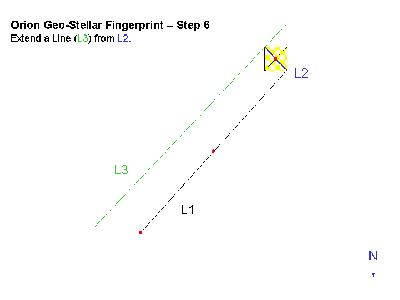
Figure 7
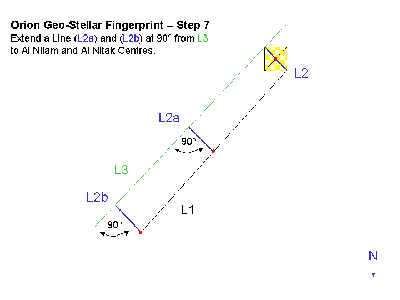
Figure 8
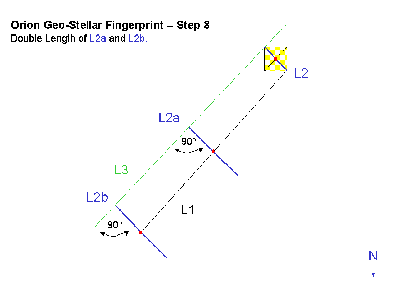
Figure 9
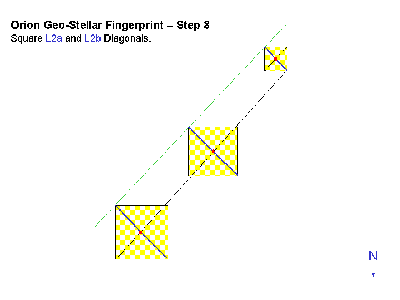
Figure 10
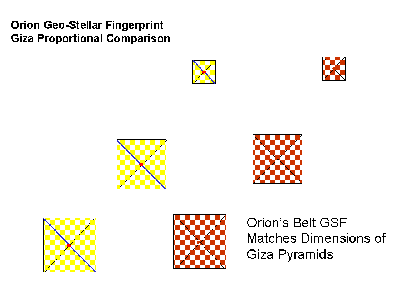
Figure 11 – Giza Orion Geo-Stellar Fingerprint Comparison
The dimensions of the three main pyramids at Giza are shown to agree proportionally with the three bases produced by the Orion Geo-Stellar Fingerprint – a clear connection between the Orion Belt Stars and the Pyramids at Giza. Furthermore, what we also find is that three lines can be passed through each of the three main pyramids of the Geo-Stellar Fingerprint that allow us to also place the Queens Pyramids of Menkaure and Khufu (Figure 12 and Figure 13).
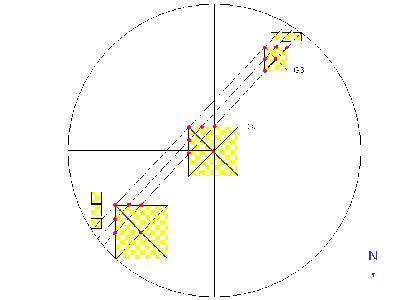
Figure 12 – Intersecting Lines Through Main Pyramids Place Queens Pyramids
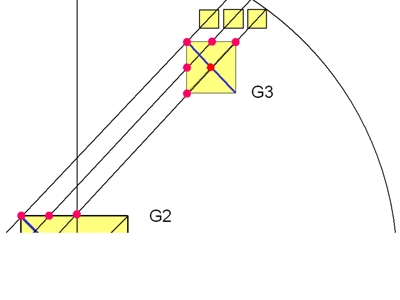
Figure 13
It seems somewhat ironic that the mathematical ‘solution’ to the Giza layout sought by so many over so many years was sought by some individuals in order to disprove Bauval’s Orion hypothesis and yet what we now find is that the Orion belt stars actually held the key to the mathematical design solution – the Giza Blueprint – that these individuals had been so keen to discover.
But the Orion influence at Giza does not end there. There is more – much more.
Whilst the Orion Geo-Stellar Fingerprint presents highly compelling evidence on its own of a direct (mathematical) connection between the three Giza pyramids and the Orion belt stars, independent corroboration of such an association is desirable in order to further strengthen the hypothesis. If it could be shown that other pyramid structures at Giza also have a demonstrable connection with the Orion belt stars (out with the obvious placement of these structures within the Orion Geo-Stellar Fingerprint – Figure 13) then this would provide the independent corroboration required to prove the Orion-Giza hypothesis – if not conclusively – then certainly beyond reasonable doubt.
Queens of Precession
It would seem that such independent corroboration can be found in the relative placement of the two sets of three ‘Queens Pyramids’ on the plateau (Figure 1).
Before presenting this corroborating evidence of an Orion association with the two sets of Queens Pyramids, it is important first to take a moment here to understand the astronomical phenomenon referred to by astronomers as ‘Precession’.
Most of us are familiar with the Earth’s daily (diurnal) rotation of 24 hours. We are also familiar with its second motion, its annual 365-day rotation (orbit) around the Sun. The Earth, however, possesses a third much less perceptible motion known as ‘Precession’.
When we look at the night sky we observe the stars slowly rotating in a continual east to west direction. Over some 13,000 years, however, the stars in our night sky actually slowly drift in a west to east (retrograde) direction before stopping and then, over a further 13,000 years, drift slowly back to their point of origin – like the swing of a clock’s pendulum. The conventional view of this ‘precessional drift’ is that it occurs as a result of a very slow wobble of the Earth as it rotates around its axis.
The end result of this ‘precessional drift’ is to slowly shift the rising and setting points of stars on the horizon over a long period of time – approximately 1º of precessional drift occurs every 72 years. One beneficial aspect of this precessional drift is that it can be utilised as a mechanism for ‘recording’ time; for marking important dates. For example, by aligning two stone obelisks with a setting star precisely due south (180º) we are effectively marking that specific moment (date) in time. Over the passing years and decades, the target star continues its slow drift along the horizon, leaving the alignment with the obelisks far behind. The obelisks no longer align with the target star on the horizon but now serve as a ‘marker’ – an astronomical record – of when the alignment was made with the target star.
By then observing where the target star sets (or rises) today – for example at 190º – we can then extrapolate that it has drifted some 10º from its original obelisk alignment of 180º which, in turn, tells us that the alignment was created approximately 720 years in the past since 72 years equals approximately 1º of precessional drift.
Similarly, when we now consider the pyramid structures at Giza we find a very clear and unequivocal alignment of those structures with the Orion belt stars as they appeared on the southwest horizon c.10,500 BCE. Specifically this alignment involves the smallest of the three great pyramids – the pyramid of Menkaure – and its stellar counterpart, the belt star Mintaka in Orion’s belt. Mintaka is the ‘target’ star through which the pyramid of Menkaure (our ‘obelisk’) is aligned.
In the year c.10,500 BCE the star Mintaka set close to the southwest horizon at 212º azimuth (i.e. 212º clockwise from due north). When considering the Giza pyramids we find that the alignment from the apex of Khafre’s pyramid (G2) through the apex of Menkaure’s pyramid (G3) is also 212º azimuth (Figure 14).
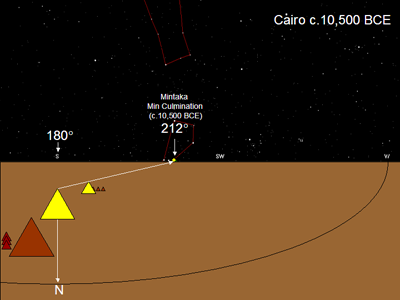
Figure 14 – Menkaure is Aligned with Mintaka at 212º Azimuth c.10,500 BCE
At the very same moment – as pointed out by Bauval/Hancock in their book, Keeper of Genesis – the three Queens Pyramids of Menkaure are placed in a horizontal line close to the SW horizon thereby mimicking the arrangement of the three belt stars which are similarly arranged at that precise moment before setting on the southwest horizon (Figure 15).
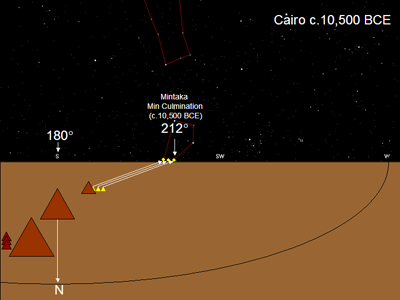
Figure 15 – Menkaure’s Queens Align Horizontally with the Belt Stars c.10,500 BCE
Significantly, this alignment with Menkaure/Mintaka and the Menkaure Queens with the three belt stars occurs at a very unique moment in the precessional ‘pendulum swing’ of the Orion belt stars. This quite unique moment – marked by the 212º Menkaure/Mintaka alignment and corroborated by the arrangement of Menkaure’s Queens’ Pyramids – is the very moment the belt stars stop and reverse their precessional direction to begin their long 13,000 year journey back to their point of origin. This unique moment in c.10,500 BCE is known as the precessional minimum culmination. After another 13,000 years drifting in the opposite direction the belt stars will reach their precessional maximum culmination around the year c.2,500 CE (Figure 16) and so the precessional pendulum swing of the belt stars continues – forever.
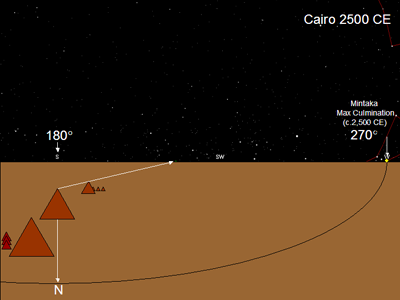
Figure 16 – Mintaka Drifts Along the Horizon to Maximum Culmination c.2,500 CE
And there is yet more evidence to present regarding this quite extraordinary relationship between the Giza Pyramids and the Orion belt stars. As already mentioned, the belt stars swing across the sky like a clock’s pendulum, moving imperceptibly slowly between minimum and maximum precessional culminations. We have observed already how the Menkaure Queens have been placed as ‘markers’ to indicate the precessional minimum culmination of the Orion belt stars when these stars were aligned in horizontal fashion close to the southwest horizon. This then begs the obvious question – how and where will the belt stars be aligned when rising at their precessional maximum culmination on the future date of c.2,500 CE?
Consulting astronomical software we find that the belt stars will rise at maximum culmination on the eastern horizon rotated 90º (i.e. perpendicular) to the stars setting at minimum culmination. Astonishingly, this is precisely the arrangement we find the other three Queens Pyramids beside Khufu’s Great Pyramid have been placed (Figure 17).
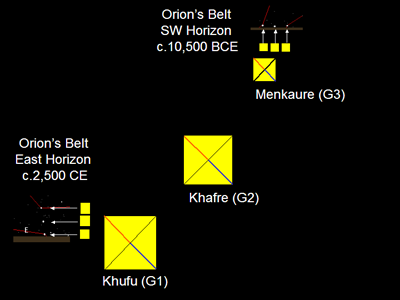
Figure 17 – Queens Pyramids Mimic Belt Stars at Max & Min Culmination
It is also worth noting that in consideration of the Queens’ Pyramids as ‘precessional markers’ this might help explain the curious absence of any Queens pyramids of Khafre (G2), a Pharaoh who reputedly had five queens. Since only the precessional max and min culminations need be demonstrated (there is little need to mark any intermediate point), thus the mysterious absence of Khafre’s Queens’ Pyramids is simply and logically explained.
In conclusion then, the two sets of Queens Pyramids at Giza demonstrate the precessional minimum (setting) and maximum (rising) culminations of the Orion belt stars, a process that takes some 13,000 years to complete one half-cycle. That such astronomical information is exhibited to us in plain view at Giza is truly extraordinary and provides strong corroboration to the Orion Geo-Stellar Fingerprint which – as we have seen – defines the base dimensions of the three main pyramids at Giza. So, in three distinct sets of structures at Giza, the constellation of Orion is clearly and unequivocally implicated thus providing corroboration to the Orion Geo-Stellar Fingerprint.
But the Orion-Giza story is not quite over yet – there is more.
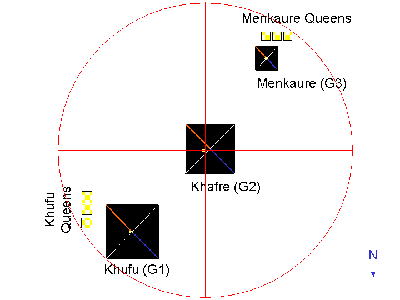
Figure 18 – Belt Stars Overlaid on Pyramid Centers G1 (Al Nitak) and G3 (Mintaka)
The Great Giza Circle Pinpoints Al Nilam Center with G2 Center Slightly Offset
One of the main points of contention opponents of the Orion-Giza hypothesis levelled at Bauval’s work was the fact that the belt stars do not present a perfect, center-to-center correlation with the three Giza pyramid centers. The error, however, is very small and indeed, it would seem that this minor error was quite intentional. We can deduce this from the fact that the Giza pyramids match the Orion Geo-Stellar Fingerprint so accurately. Such an accurate match could only have been created from having made a near perfect observation and recording of the belt star asterism.
Furthermore, when we place the belt stars over the pyramid centers we find that the center star (Al Nilam) is slightly offset from its pyramid center. However, when we circumscribe the pyramids precisely within a tight circle using the three most extreme pyramid corners to define the circle’s circumference, we find that the center of this Great Giza Circle (GGC) lies almost perfectly on the center of Al Nilam (Figure 18).
It seems then that the ancient designers of Giza measured and placed the belt star asterism with high accuracy on the ground at Giza but for some reason decided to place Khafre’s pyramid (G2) slightly offset from the Al Nilam/GGC center.
Intriguingly, independent researchers, Scott Sacharczyk and Rob Miller, have found that the offset between Khafre center and the center of the Great Giza Circle measures precisely 44cubits x 14cubits (Figure 19) which represents an approximation of Pi – 44/14 (or reduced to 22/7) = 3.14285714, thus presenting the possibility that the G2 offset was deliberately created to encode the Pi formula and, by extension, the Great Giza Circle.
Uniquely for Khafre’s pyramid it has two entrances., a feature which some scholars (Edwards, Verner, Fakhry and Maragioglio & Rinaldi) regard as perhaps indicating that the location of Khafre’s pyramid was changed from an earlier planned location which would have placed it slightly further north and east of where it presently stands. This view agrees with the findings of the Orion Geo-Stellar Fingerprint and the center of the Great Giza Circle.
What we see with this design method is that all three main pyramids were designed from the NE/SW line known today as the ‘Lehner Line’. However, what is also observable is that G2 – although its dimensions were likely designed from the Lehner line in the manner described – it was then subsequently moved from its original design position on the Lehner line although, it should be noted, that G2’s platform connects with the Lehner line.. We might reasonably ask why should it be that G2’s platform connects to the Lehner line but the pyramid itself does not? Why was G2 moved away from its design position on the Lehner line?
If we now look at the Giza site plan, we can see that the centre pyramid is moved off the Lehner line (figure 21)
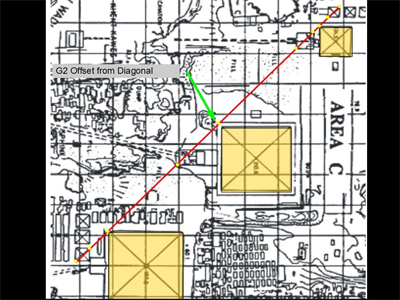
The answer to this divergence from the design plan (i.e. the Geo-Stellar Fingerprint) may be remarkably simple. If weconsider the belt stars in the sky and imagine a line connecting Al Nitak (G1) and Mintaka (G3), what we find then is that the centre star, Al Nilam (G2), lies off this imaginary line (figure 20):
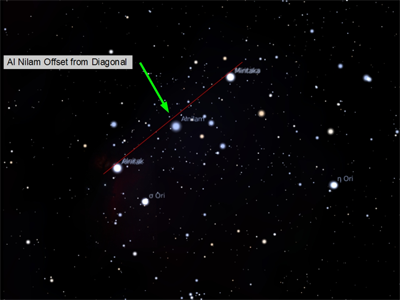
Thus the divergence of G2 from the Geo-Stellar plan is explained and the concordance of Orion’s Belt with the Giza pyramids further enhanced.

Figure 19 – Khafre (G2) Offset from GGC Center Demonstrates Pi (44/14 = 3.14)
To summarize then, through the arrangement and dimensions of the various structures at Giza we are presented with multiple pieces of quite diverse evidence all pointing to a clear connection of the Giza pyramids with the belt stars of the Orion constellation. With this mathematical and astronomical evidence – together with the mass of cultural evidence previously cited by Bauval, Gilbert and Hancock supporting such a correlation – for Egyptologists to continue to reject that such an association was fully intended by the ancient designers surely now must be considered an untenable position. A sufficient body of evidence now exists to allow us to conclude safely that the structures at Giza were constructed with reference to a pre-defined, master plan. The evidence presented here in support of this view may not conclusively prove an Orion-Giza association but it is probably fair to say that if it is weight of evidence that counts then we must consider that the Orion-Giza association now has sufficient evidence to allow us to consider the hypothesis as proven beyond reasonable doubt.
Giza – ‘Clock of Ages’
In acceptance of the Orion association with the Giza pyramids, what remains now is to consider the ‘why’ question; why did the ancient designers expend so much blood, sweat and tears to create this great astronomical clock, indicating the past date of c.10,500 BCE and the future date of c.2,500 CE? Why are the ancient designers indicating this 13,000 year half-cycle of time in a series of monuments that could easily have been built to survive such a lengthy period of time – and more? And is it perhaps significant that around c.10,500 BCE – the first date indicated in the astronomical clock – the last Ice Age came to an abrupt and somewhat dramatic end with all manner of animal and plant species becoming extinct at that time? What event could have occurred on the Earth to bring about such dire global consequences?
Whatever the reason that inspired the design and later construction of this quite monumental astronomical ‘Clock of Ages’ at Giza, it seems evidently clear that the reason must have been one of vital importance. The two sets of Queens’ Pyramids at Giza present the belt stars of Orion aligned in two different ways, indicating two different dates: a horizontal alignment (minimum culmination indicating c.10,500 BCE) and a perpendicular alignment (maximum culmination indicating c.2,500 CE). Our civilization ignores the dates indicated to us with these two alignments – these Orion ‘signs’ – at our peril.





